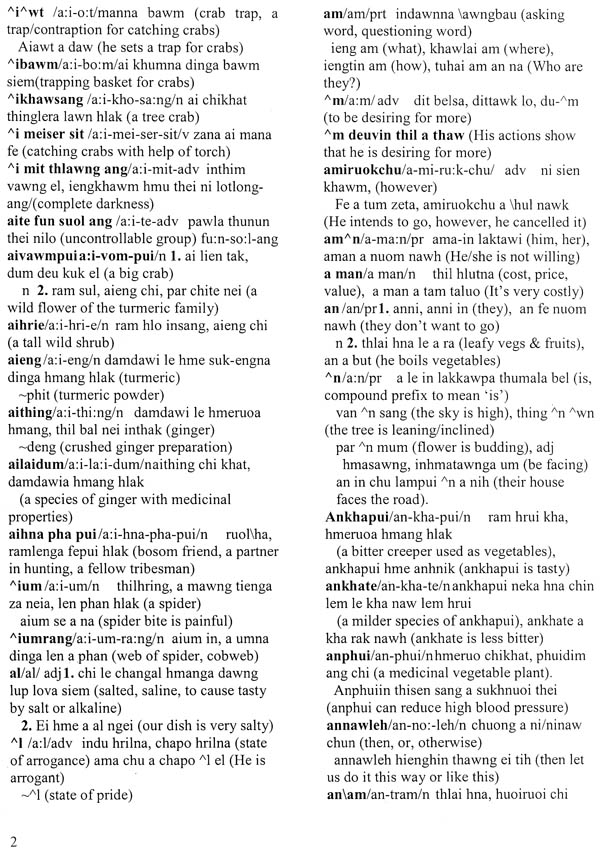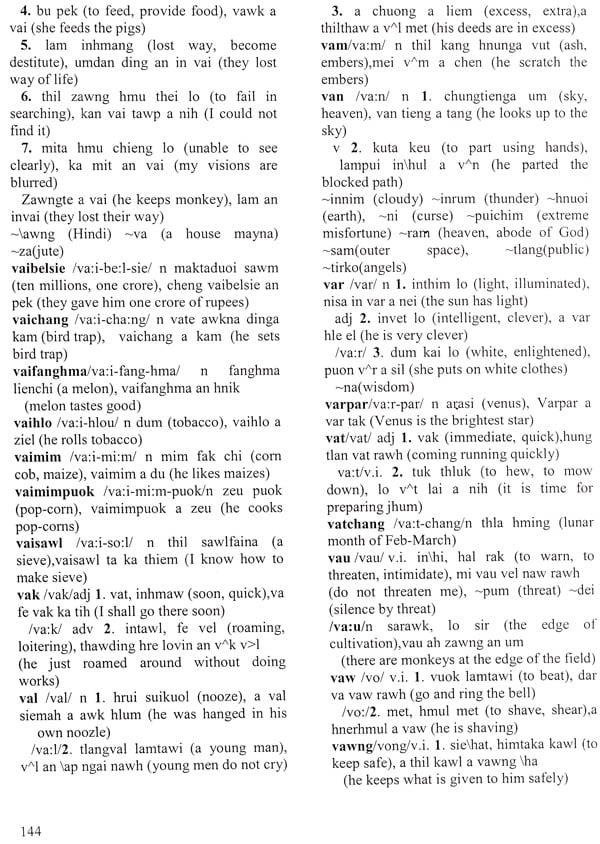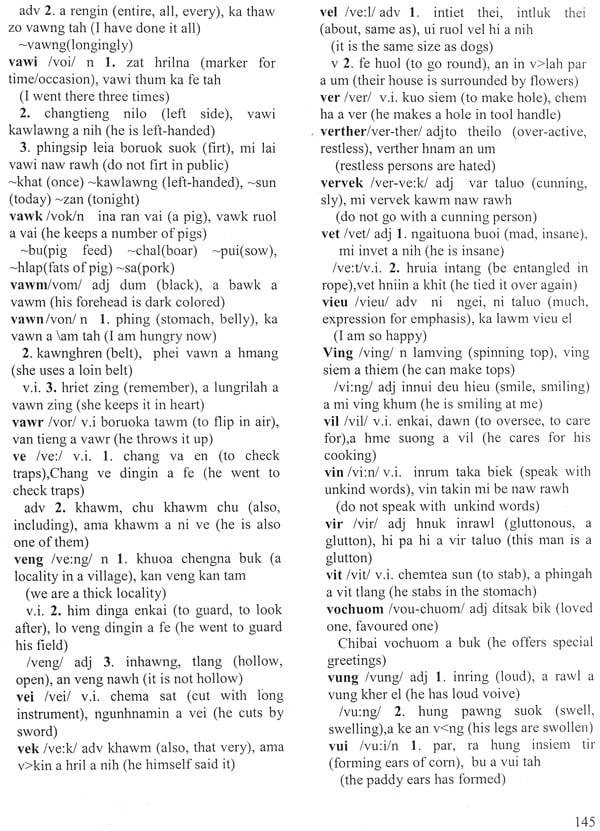
Hmar-Hmar English Dictionary
Book Specification
| Item Code: | NAW200 |
| Author: | Vanlal Tluonga Bapui and Kedutso Kapfo |
| Publisher: | Central Institute Of Indian Languages, Mysore |
| Language: | Hmar and English |
| Edition: | 2011 |
| ISBN: | 9788173431029 |
| Pages: | 158 |
| Cover: | PAPERBACK |
| Other Details | 10.50 X 8.50 inch |
| Weight | 430 gm |
Book Description
The Central Institute of Indian Languages was set up on the 17th July, 1969 with a view to assisting and coordinating the development of Indian Languages. The Institute was charged with the responsibility of serving as a nucleus to bring together all the research and literary out- put from the various linguistic streams to a common head and narrowing the gap between basic research and developmental research in the fields of languages and linguistics in India. In this connection, preparation of dictionaries of as many Indian languages as possible has been one of the major aims of this Institute. Dictionaries present us a rare window to look inside a language, and form an idea of the semantic map of the native speakers of the language concerned. | have also said elsewhere that Jean Cocteau is credited to have said, "The greatest masterpiece in literature is only a dictionary out of order". In the beginning, the western world knew only glossaries that were products of notes scholars made on the margin of difficult texts - originally written in Latin. In the Indian set-up, the commentaries or the Tiikaas served that purpose. In the western world, the year 1604 was important as that was when we saw Robert Cawdrey's A Table Alphabetical, marking a beginning of a tradition to explain the "hard" words, as he declared on the cover. "A Table Alphabetical, containing and teaching the true writing, and understanding of hard usual English words, borrowed from the Hebrew, Greek, Latin or French and etc., with the interpretation thereof by plain English words, gathered for the benefit and help of Ladies, Gentlewomen, or any other unskillful persons". He had already made his point, and this gave rise to more such works in an excitingly new field, the field of Lexicography. However, the more serious attempt began with the publication of A New English Dictionary by J.K. in the 18" century. But dictionaries became commercial tools only with the publication of Webster's and Worcester's. As we all know, this last century was full of dictionaries, but with one group leaning towards prescription, and another with a clear preference towards description. Many even raised doubts as to whether there could be any truly descriptive dictionary.
Lexicography has similarly evolved in the Indian sub-continent, too, as documenting new ways of creating and managing words of one's own languages. The present Hmar-Hmar English Dictionary of about 3000 plus headwords, prepared by a team under the leadership of Dr. Kedutso Kapfo, is one such attempt which tries and connects two languages that have been a long-felt need of the particular speech community from Assam, Manipur and Mizoram. From our end, at this Institute, we expect that this tool will be used to promote healthy bilingualism (by especially those who wish to negotiate between Hmar and English) giving rise to many new works of translation and interpretation.
The current team spent a long time in producing,- checking, testing and finalizing this work. And it has been a product of a lot of hard work. The Institute would feel rewarded if the users derive maximum benefit out of this work.
The suggestions, comments, criticisms from all those who may use this teaching material will be most welcome.
The Hmar language is one of the up-coming Indian Languages of the country. Hmar is widely spoken in Manipur, Assam, Mizoram, Tripura, and Meghalaya. G.A.Grierson has documented the language in Linguistic Survey of India in the Nineteenth Century. The Christian Missionaries made it a written language at the turn of the Twentieth Century. Though the language was reduced to a written one for less than a century, the language has made quite a remarkable progress. The language is now recognized as medium of instruction upto the Upper Primary in Manipur and Assam, and the language has been recognized for study upto the first Degree level both in Manipur University and Assam University as a language paper.
The need of a standard Dictionary of the Language is very urgent and real. Though there are works of word books and dictionaries, they lack the aspects required of a standard language dictionary. The present volume is the result of workshops on NE Languages held at different locations.
The Hmar alphabet is a modified Roman script with some diacritic marks to help pronounce the language correctly. There are 6 vowel and 19 consonants to write the language and these have been used to write the language. The language is somewhat standardized, but there still remains some areas which need for improvement by way of further standardization.
The Hmar alphabets are A, AW, B, CH, D, E, F, G, NG, H, I, J, &, L, M, N, O, P, R,S, T, =, U, V and Z. Of these G and J are used only for transliteration of place names and words from other languages. They are pronounced as follows —
a as in father
aw as in omnipotent
b as in bell, ball
ch as in church, challenge
d as in day, dumb
e as in escape, enter.
f as in flower, flow.
g as in gun, goal.
n as in thing, ring
h as in hut, hand
i as in inn, India
j as in Jaco
k as in king, kin.
l as in long, lame
m as in mother, main.
n as in name, number
o as in no, also.(pronounced like ou)
p as in pain, people.
r as in ram, rule.
s as In same, sum
t as in tell, time.
as in tree, trunk
u as OO In moo, shoo
v as in victory
z as in zeal, zombie.
Long vowels are marked in Hmar as * "w > $ < and short vowels are not marked. / is very prominent and is nasal. Combination of consonants like thl, hn, hm, hr, are distinctive in Hmar.
In this Dictionary, phonetic alphabets are not used to show the pronunciations. The syllables are separated by a hyphen (-) in between them. Long vowels are marked by the usual sign of (:) after the vowels. These are done to help non-native speakers as well as the native speakers themselves. We do hope that the Hmar words could be correctly pronounced with their help.
Hmar is a semi-tonal language in that some meanings change with slight change in intonation. However, no marker has been used in this Dictionary to show the high and low tone. As stated above, meaning of words also change for short and long vowels in many cases. Non- native speakers will do well to note this aspect. Stress marks are also not used so as to avoid confusion. Tones also tend to vary among speakers of lesser dialects among the tribe.
Any suggestion for improvements will be welcomed.
**Contents and Sample Pages**









